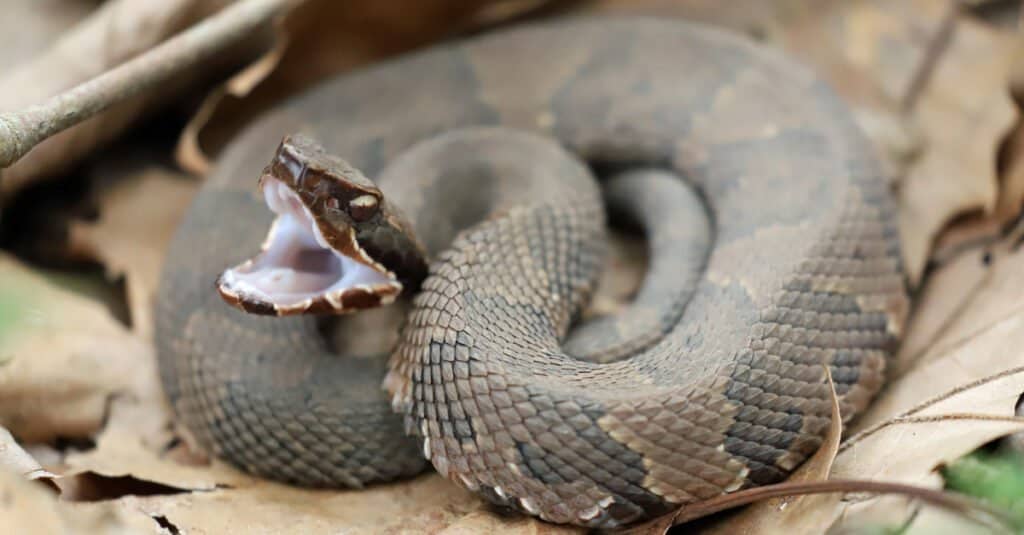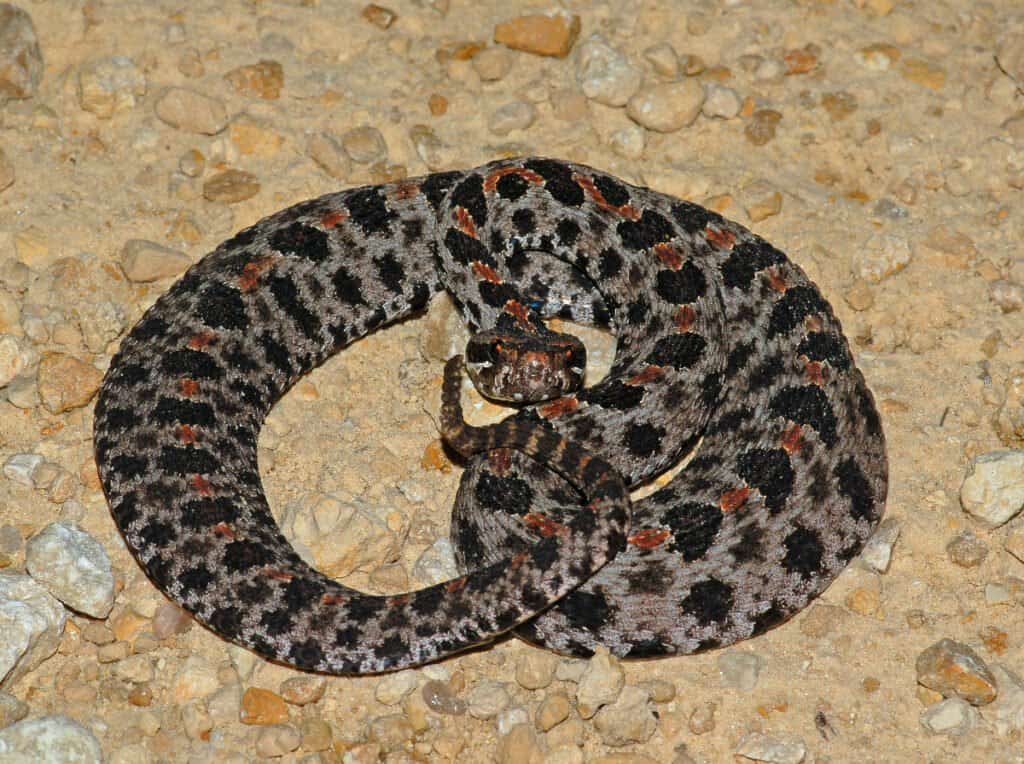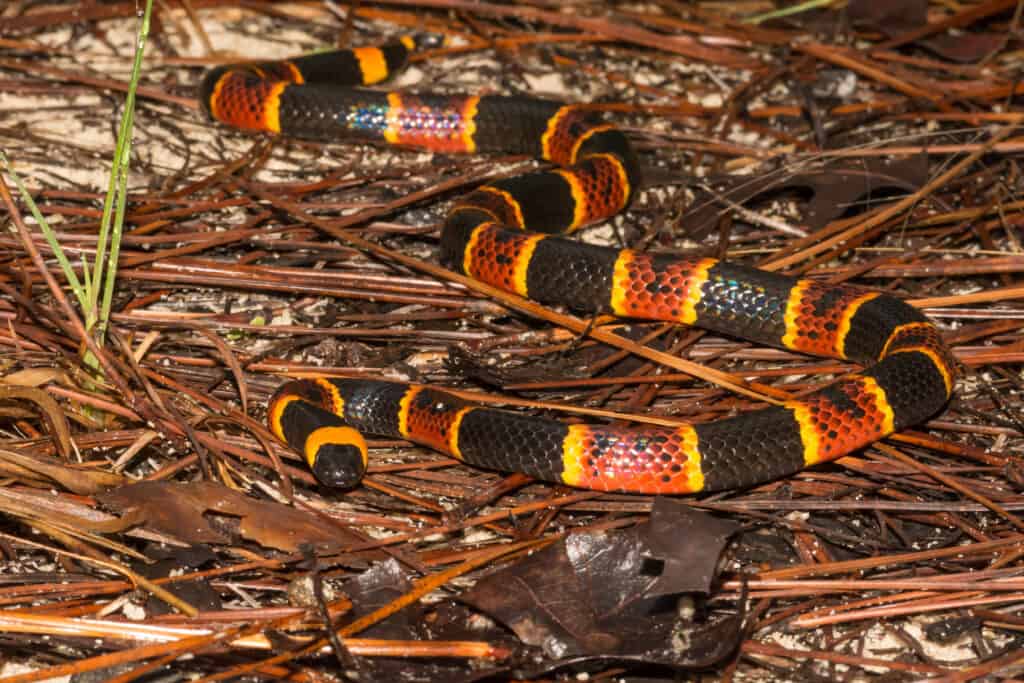If you’re planning on spending any time outdoors in Mississippi this summer, you might want to educate yourself on the venomous snakes of Mississippi. Mississippi is home to over 50 snake species, only six of which pose any threat to humans. Of those six, some live in dry regions, while others live in swamps and freshwater sources. They range in size from just a couple of feet long to over five feet long. Some are deadlier than others, but you don’t want to sustain a bite from any of Mississippi’s venomous snakes.
They may not be as deadly as the black mamba or the inland taipan, but the venomous snakes of Mississippi are nothing to be messed with. Snakes are venomous animals- and not poisonous. This is because they inject toxins rather than ingest them. Here, we’ll learn more about the six types of venomous snakes found in the state. We’ll discover what they look like, how dangerous they are, and where each is found.
Read on to learn more about the deadly snakes of Mississippi!
6. Copperhead (Agkistrodon contortrix)

Copperheads live throughout much of the southeastern United States.
©Daulton Moore/Shutterstock.com
Copperhead snakes of Mississippi are hard to confuse. They’re the only snakes in the state with the characteristic hourglass pattern. Adults are 24-40 inches long, with a base color of tan. The hourglass markings are dark brown at the edges, tending towards light brown in the centers. Baby copperheads have bright yellow or green tails.
Like all pit vipers, copperheads have wide, triangular heads, large front fangs, and heat-sensing pits. They’re most common in dry, rocky areas—particularly those with sources of cover, like brush or building debris. Copperheads have a toxic bite, but they’re almost never life-threatening. They eat rodents, small mammals, lizards, snakes, birds, amphibians, and insects.
5. Cottonmouth (Agkistrodon piscivorus)

Water moccasins, also known as cottonmouths, are among the most reviled of all snakes in the southeastern United States.
©KF2017/Shutterstock.com
Cottonmouth snakes of Mississippi get their name from the cottony white interior of their mouths. These snakes have heavy bodies and grow to be 2-4 feet long as adults. They’re primarily found in or near freshwater and may be seen basking near the water’s edge. However, cottonmouths are semi-aquatic and rarely climb trees. These snakes have dusky brown bodies marked by irregular bands of light and dark brown.
Cottonmouths are famous for aggressively standing their ground, and bites are not uncommon. Their venom is toxic, and any bite warrants immediate medical treatment. Like copperheads, cottonmouths have triangular heads with large venom glands and cat-like pupils. They eat fish, amphibians, baby turtles and alligators, lizards, birds, and small mammals that stray too close to the water.
4. Pygmy Rattlesnake (Sistrurus miliarius)

Pygmy rattlesnakes live only in the southeastern United States, including throughout Florida.
©Gerald A. DeBoer/Shutterstock.com
These snakes of Mississippi grow to between 14-22 inches long as adults. As their name suggests, they’re some of the smallest venomous snakes in the state. Pygmy rattlesnakes have variable appearances and may present as tan, gray, or lavender. They have irregular dark blotches interspersed with reddish bars along their backs. Like all rattlesnakes, they have tiny rattles at the ends of their tails.
These snakes typically live near sources of freshwater in areas that offer them plenty of cover, like pine sandhills and mixed forests. Pygmy rattlesnakes are venomous and eat lizards, small mammals, insects, and amphibians. They’re generally shy and only bite when provoked.
3. Canebrake Rattlesnake (Crotalus horridus)

Also known as the timber
rattlesnake
, canebrake rattlesnakes live throughout much of the southeastern United States.
©Frode Jacobsen/Shutterstock.com
These snakes of Mississippi have heavy bodies and grow to be between 30-60 inches long. They’re among the largest venomous snakes in the state, and their bite is not something you want to mess with. Canebrake rattlesnakes have base tan or light gray scales, with regular, darker hexagonal bands ringing their bodies. Further, their heads are much wider than their bodies. Like all pit vipers, canebrake rattlesnakes have potent venom, hinged fangs, and heat-sensing pits.
These snakes live primarily in terrestrial areas close to fresh water. Humans may encounter them in agricultural fields, rocky hillsides, cane thickets, or even mixed forests or mountainous zones. Canebrake rattlesnakes eat mostly small mammals, like rats, mice, squirrels, and rabbits.
2. Eastern Diamondback Rattlesnake (Crotalus adamanteus)

Eastern diamondbacks have a very restricted range that includes only the coastal parts of the southeastern United States.
©Chase D’animulls/Shutterstock.com
These snakes of Mississippi have heavy bodies, and grow to between 33-72 inches long as adults. Additionally, eastern diamondback rattlesnakes are the largest venomous snakes in Mississippi, and their bite certainly packs a punch to match their size. These snakes have light brown bodies with regular, intricate diamond patterns made up of light and dark brown scales. Their heads are triangular, and they have rattles at the tips of their tails.
Eastern diamondback rattlesnakes live mainly in areas with thick underbrush, like palmetto thickets. They eat small mammals, like rabbits, squirrels, and rodents. Like the other venomous snakes of Mississippi, a bite from an eastern diamondback rattlesnake requires immediate medical intervention.
1. Coral Snake

Coral snakes live in the coastal parts of the southeastern United States.
©Jay Ondreicka/Shutterstock.com
These snakes of Mississippi are among the most colorful of all venomous snakes. Coral snakes grow to be between 18-30 inches long, making them some of the state’s smallest venomous snakes. Further, unlike the other snakes on our list, coral snakes have heads of the same width and shape as their bodies. They’re characterized by regular bands of black, yellow, red, yellow, and back to black.
Coral snakes are fossorial, meaning they’re adapted for burrowing and life on the ground. They live in shrubby areas or wooded flatlands. These snakes mainly eat other snakes and lizards; humans only rarely see them. Coral snakes are non-aggressive, and only bite if provoked.
The photo featured at the top of this post is © Scott Delony/Shutterstock.com
Discover the "Monster" Snake 5X Bigger than an Anaconda
Every day A-Z Animals sends out some of the most incredible facts in the world from our free newsletter. Want to discover the 10 most beautiful snakes in the world, a "snake island" where you're never more than 3 feet from danger, or a "monster" snake 5X larger than an anaconda? Then sign up right now and you'll start receiving our daily newsletter absolutely free.
Thank you for reading! Have some feedback for us? Contact the AZ Animals editorial team.






